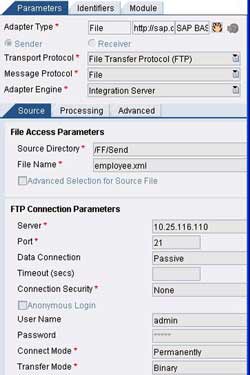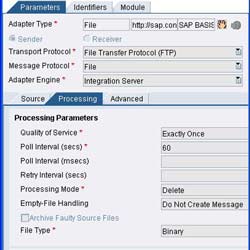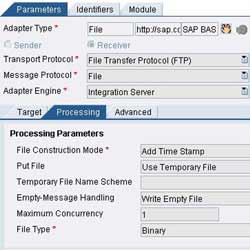
In this article series we will discuss the nitty gritties of the SAP XI File Adapter. First we will understand the File adapter in its most basic form. Then we will have a look at File content conversion with simple and complex file structures.
 File Adapter converts incoming file into XML and vice versa. The adapter resides on the J2EE stack of the XI server. It can read/write files directly from/to the XI server at the OS level using File System protocol. It also works using FTP protocol, using which it can read/write files from/to any server location. Configuration of File Adapter is quite simple and straightforward.
File Adapter converts incoming file into XML and vice versa. The adapter resides on the J2EE stack of the XI server. It can read/write files directly from/to the XI server at the OS level using File System protocol. It also works using FTP protocol, using which it can read/write files from/to any server location. Configuration of File Adapter is quite simple and straightforward.
File Sender Adapter
Select the Transport protocol as FTP or NFS and Message Protocol as File. Specify the Directory and filename from where the source file needs to be picked up. File type can be either text (or XML) or binary. In case of FTP protocol, you will need to provide FTP connection parameters as well.
 The adapter supports all the three QoS namely BE (Best Effort), EO (Exactly Once) and EOIO (Exactly Once in Order). Specify QoS as per your scenario. Poll Interval indicates the time interval between two consecutive attempts by XI to read the files from source directory. Processing mode defines how the file should be handled once it is processed by the adapter engine. If you specify a queue name (in case of EOIO) it is automatically created in XI.
The adapter supports all the three QoS namely BE (Best Effort), EO (Exactly Once) and EOIO (Exactly Once in Order). Specify QoS as per your scenario. Poll Interval indicates the time interval between two consecutive attempts by XI to read the files from source directory. Processing mode defines how the file should be handled once it is processed by the adapter engine. If you specify a queue name (in case of EOIO) it is automatically created in XI.
File Receiver Adapter
 Select the Transport protocol as FTP or NFS and Message Protocol as File. Specify the Directory and filename where the target file is to be put. Target directory if it does not exist gets created automatically. Specify connection parameters in case of FTP protocol. You can specify the File Construction mode as per your choice. QoS possible here are EO and EOIO and is inherited from the Integration Server.
Select the Transport protocol as FTP or NFS and Message Protocol as File. Specify the Directory and filename where the target file is to be put. Target directory if it does not exist gets created automatically. Specify connection parameters in case of FTP protocol. You can specify the File Construction mode as per your choice. QoS possible here are EO and EOIO and is inherited from the Integration Server.
To see an example of file adapter using NFS protocol, go through this article about File to IDoc scenario.
In the next part we shall discuss setting up File Adapter for File Content Conversion with simple structure (CSV File) at sender and receiver end.